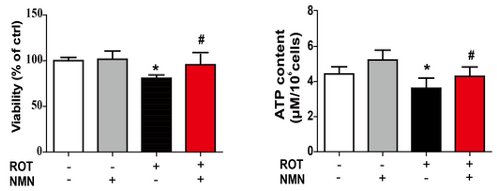Key Points:
- NMN prevents neuron death by improving the function of mitochondria in mouse cells modeling Parkinson’s disease (PD).
- Honokiol and icariin, which activate the NAD+ consuming enzyme SIRT3, prevent neuron death and improve the motor performance of a rat model for PD.
Our cells utilize hundreds of enzymes to operate on a daily basis, yet few are well-renowned for their lifespan-extending and anti-aging effects as sirtuins. Considering that disorders like Parkinson’s and Alzheimer’s disease are a consequence of aging, enhancing the activity of sirtuin enzymes may provide a key to treating these incurable diseases.
In a preprinted (in the process of being peer-reviewed) article published in Molecular Neurobiology, researchers from Zunyi Medical University in China report that sirtuin activators NMN, icariin, and honokiol have a protective effect on models for PD. Shen and colleagues show that nicotinamide mononucleotide (NMN) prevents the death of neurons involved in motor movements (dopamine neurons) by improving mitochondrial function. Furthermore, honokiol and icariin also prevent the death of rat neurons while improving their motor performance, suggesting that these sirtuin activators could treat the symptoms of PD.
NMN Prevents Neuron Death in Parkinson’s Model
Many of us are familiar with dopamine as the neurotransmitter associated with reward. However, dopamine also modulates our voluntary movement. In the brains of PD patients, dopamine neurons — the neurons that release dopamine — are degenerated, manifesting in the symptoms of PD, including uncontrollable movements like tremors. To model PD, Shen and colleagues exposed dopamine neurons to rotenone (ROT), a chemical that causes neuron death. They showed that treating these neurons with NMN prevented much of this death, demonstrating a neuroprotective effect.

Damaged mitochondria have been observed in the dopamine neurons of PD patients. Mitochondria are necessary for the production of ATP, the molecule cells use for energy. ROT causes neuron death by damaging mitochondria, leading to diminished ATP production. Shen and colleagues confirmed this by showing that ROT decreased ATP production in mouse dopamine neurons. They then showed that NMN treatment recovered ATP production, suggesting that NMN could increase PD dopamine neuron survival by promoting bioenergy production.
Honokiol and Icariin Rescue PD Defects
One way to activate sirtuins is by providing them with more fuel, which is precisely the role of NMN. As a precursor to NAD+ (nicotinamide adenine dinucleotide), NMN provides the substrate needed to boost NAD+ levels. Sirtuin enzymes consume NAD+ as fuel, increasing their activity. Sirtuins can also be activated by more direct means, such as through molecules like honokiol (HNK) and icariin (ICA). HNK and ICA enhance the activity of sirtuin3 (SIRT3), a specific type of sirtuin that directly modulates mitochondrial ATP production.
Through a series of experiments, Shen and colleagues showed that activation of SIRT3 by HNK and ICA improves the function of mitochondria, rescues ATP production, and increases dopamine neuron survival. These findings demonstrate that HNK and ICA, like NMN, recover mitochondrial function to prevent modeled neurodegeneration, suggesting that NMN may have a similar effect via SIRT3 activation.
Shen and colleagues next injected rats with ROT to induce neurodegeneration and establish an animal PD model. The rats were then subjected to a Rota-Rod test, where they were placed on a moving rod, and the time taken for them to fall was measured. It was shown that the ROT rats fell quicker than untreated rats, suggesting worsened motor performance. However, ROT rats treated with HNK or ICA stayed on the rod longer, suggesting that HNK and ICA improve the deficits in motor performance associated with PD.

Honokiol has recently been shown to improve cognitive deficits in mouse models for Alzheimer’s disease by modulating gut bacteria and improving mitochondrial function. Also, this year, icariin was shown to improve the memory of Alzheimer’s mice by regulating sugar metabolism. Furthermore, icariin has previously been shown to have neuroprotective effects in numerous studies. While the benefits of these plant compounds still need to be tested in humans, it seems they can improve the cognitive deficits associated with neurodegeneration.
Like honokiol and icariin, NMN has been shown to improve the cognition of mice modeling Alzheimer’s disease. NMN treatment also improves the cognition of a rat model for vascular cognitive impairment, the second leading cause of dementia after Alzheimer’s. Moreover, NMN, in combination with lycopene, an antioxidant found in tomatoes, improves cognition in a mouse model for aging. Therefore, while human studies are needed, NMN is also a promising potential treatment for the cognitive decline associated with neurodegeneration.